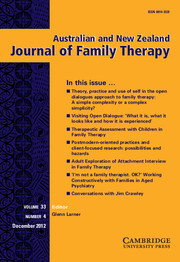Crossref Citations
This article has been cited by the following publications. This list is generated based on data provided by
Crossref.
Beauchamp, Julie
2013.
An Interview with Laurie MacKinnon, PhD, 2012 ANZJFT Special Award Recipient and A Personal Tribute by Kerrie James.
Australian and New Zealand Journal of Family Therapy,
Vol. 34,
Issue. 1,
p.
75.
Battle, Christina
Bendit, Janine
and
Gray, Rebecca
2014.
Groupwork for Parents whose Children are in Care: Challenges and Opportunities.
Australian and New Zealand Journal of Family Therapy,
Vol. 35,
Issue. 3,
p.
327.
MacKinnon, Laurie
2014.
Deactivating the Buttons: Integrating Radical Exposure Tapping with a Family Therapy Framework.
Australian and New Zealand Journal of Family Therapy,
Vol. 35,
Issue. 3,
p.
244.
Lander, Itzhak
2014.
Expanding the Horizons of Forgiveness Therapy: A Cross-Cultural Application with a Bedouin-Arab Woman.
Clinical Social Work Journal,
Vol. 42,
Issue. 4,
p.
395.
McIlwaine, Fiona
and
O'Sullivan, Kerry
2015.
‘Riding the Wave’: Working Systemically with Traumatised Families.
Australian and New Zealand Journal of Family Therapy,
Vol. 36,
Issue. 3,
p.
310.
Wood, Sarah J.
2015.
Rearranging the Puzzle: Working Systemically with Stepfamilies when Parents Re‐partner.
Australian and New Zealand Journal of Family Therapy,
Vol. 36,
Issue. 2,
p.
245.
Richardson, Katrina
2016.
Family Therapy for Child and Adolescent School Refusal.
Australian and New Zealand Journal of Family Therapy,
Vol. 37,
Issue. 4,
p.
528.
Skinner, Lynda
and
McLean, Loyola
2017.
The Conversational Model and Child and Family Counselling: Treating Chronic Complex Trauma in a Systemic Framework.
Australian and New Zealand Journal of Family Therapy,
Vol. 38,
Issue. 2,
p.
211.
MacKay, Linda M.
2017.
Special Issue: Relational Trauma and Family Therapy.
Australian and New Zealand Journal of Family Therapy,
Vol. 38,
Issue. 4,
p.
557.
Gatfield, Emma
and
Ho, Raymond
2017.
Exploring Patterns of Relationship Between Trauma Symptomization and Family Constellation: Implications for Working With Trauma Presentations in Systemic Practice.
The American Journal of Family Therapy,
Vol. 45,
Issue. 4,
p.
220.
Ratnamohan, Lux
MacKinnon, Laurie
Lim, Melissa
Webster, Richard
Waters, Karen
Kozlowska, Kasia
Silberg, Joyanna
Greenwald, Ricky
and
Ribeiro, Monique
2018.
Ambushed by Memories of Trauma: Memory-Processing Interventions in an Adolescent Boy with Nocturnal Dissociative Episodes.
Harvard Review of Psychiatry,
Vol. 26,
Issue. 4,
p.
228.
MUKBA, Gamze
SANBERK, İsmail
and
AKBAŞ, Turan
2019.
Öykü Anlatıcılığı ile Sistemik Müdahaleyi İçeren Eklektik Bir Müdahale.
Psikiyatride Güncel Yaklaşımlar,
Vol. 11,
Issue. 3,
p.
386.
McIlwaine, Fiona
Proctor, Kerry
O’Sullivan, Kerry
and
Manley, Lynda
2020.
Practitioners’ Perspectives: Partnering with Families in Out of Home Care (OOHC) – From ‘On the Outer’ to Shared Caring.
Residential Treatment For Children & Youth,
Vol. 37,
Issue. 4,
p.
327.
Amorin‐Woods, Deisy
Fraenkel, Peter
Mosconi, Andrea
Nisse, Martine
and
Munoz, Susana
2020.
Family Therapy and COVID‐19: International Reflections during the Pandemic from Systemic Therapists across the Globe.
Australian and New Zealand Journal of Family Therapy,
Vol. 41,
Issue. 2,
p.
114.
Thompson, Jessy
2022.
Culturally Safe Integrative Systemic Therapy for First Nations Families Living with Borderline Personality Disorder.
Australian and New Zealand Journal of Family Therapy,
Vol. 43,
Issue. 1,
p.
118.


